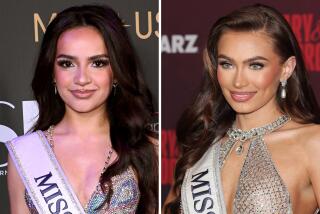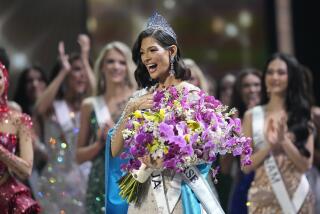Universal Appeal
- Share via
PORT-OF-SPAIN, Trinidad — The chant came with tears and thousands of outstretched arms. It came with the awe-struck stares of schoolchildren, the rock-star worship of teenagers and the proud smiles of four generations:
“Wen-dy! Wen-dy! Wen-dy! Wen-dy! Wen-dy!”
For an entire week earlier this month, the chant echoed throughout Trinidad and Tobago as this tiny nation followed every move and hung on every word of a 6-foot-tall law student now dubbed the most beautiful young woman in the universe. “An Egyptian princess born of Trinidad, a Nefertiti for the ‘90s,” as one local analyst observed.
They mobbed her as she hugged children with AIDS, sang Calypso tunes and spoke out for racial equality. They applauded as the government renamed the hospital’s pediatric wing after her, and they cheered when local officials changed Diamond Boulevard to Wendy Fitzwilliam Boulevard, because she is “the true gem of our nation.”
Cabinet ministers and local mayors welcomed her as royalty and proclaimed her the new Princess Diana. The government announced it was spending $100,000 on a new series of postage stamps featuring her likeness. The capital’s Roman Catholic archbishop praised her for humbly doing “God’s work.” And U.N. officials meeting here appointed her a goodwill ambassador in the global fight against AIDS.
Such was the scene when Wendy Fitzwilliam, 25, one of Los Angeles’ newest celebrity residents, kicked off her one-year reign as Miss Universe by coming home--a one-week tour of “Wendy-mania” in a Caribbean nation where beauty is more than skin-deep.
Fitzwilliam’s homecoming spoke volumes about a land where the beauty-queen business is a thriving cottage industry, a source of national pride and a carefully crafted ticket to fame and fortune for a generation of young women.
The articulate, soft-spoken Fitzwilliam is, in fact, the second Miss Universe in two decades to emerge from Trinidad and Tobago, a nation of just 1.3 million people tucked in a far-off corner of the southern Caribbean that has also produced a Miss World and consistently placed in the top 10 in both pageants.
But Fitzwilliam symbolizes the changing role of beauty queens as the world approaches the end of the millennium: Even the most outspoken feminists in this little-known yet cosmopolitan nation saw in Fitzwilliam an ideal model for the global woman of the late ‘90s.
“She’s the perfect package physically, but I am more interested in her brain, the fact that it’s obvious she has one,” observed Dara Healy, who writes a weekly column here called “The Nineties Girl.”
“The sweet irony about Wendy is that she has entered our consciousness from the very bowels of that male--mind you, white male--dominion. . . . Nonetheless, she has managed to portray the very strong image of a woman who understands the politics of beauty and intends to play the game to her advantage.”
Fitzwilliam already has. Her visit, which eclipsed all other news as it played out in photos across the front pages of every newspaper and filled all but a few minutes of the evening television news, was seen by most Trinidadian analysts as an opportunity to unify the nation.
The homecoming came at a time when Trinidad has its first ethnic Indian government, and when racial tension is simmering between the country’s large Indian and African communities--both descendants of indentured workers and slaves brought to work the fields for the British a century and a half ago.
Fitzwilliam, who is black but equally beloved by Trinidad’s East Indians, was used as a symbol that crossed racial boundaries and appealed to both ethnic communities.
“I want them to use me for that purpose,” she said in an interview with The Times.
“We have to stop giving our politicians so much of a voice on the racial issue. I’ve been begging our media to stop printing the opinions of a couple of very narrow-minded politicians who are encouraging racial tension.”
At the end of the seven-day tour officially dubbed “Wendy Week,” Port-of-Spain’s archbishop, Anthony Pantin, thanked her in a letter: “You have united our people in a way that is very much needed at this time, and I hope and pray that your present popularity will continue to have a good effect on the entire nation.”
But Fitzwilliam insisted during her visit here that she has no plans to convert a fame that crosses Trinidad’s racial lines into a political career, as several former beauty queens have done in the region.
“I didn’t expect to be drawn into politics here. I have zero political aspirations. That’s not for me. It takes a certain personality to be a politician. You can start out with the very best of intentions, and then somehow things go astray.
“Once you’ve gotten power, you spend most of your time paying off the people who helped you get it.”
Rather, Fitzwilliam, who will spend the year ahead based in the Miss Universe apartment on Wilshire Boulevard in Los Angeles, said she is well aware that the serious component of her reign often will be eclipsed by the superficial--seemingly endless fashion events to promote products that buy into the Miss Universe licensing system.
“Yes, of course, you must be attractive,” she said. “Come on. This is a business.”
*
The story behind the world that produced Wendy Fitzwilliam is the flip side to that of nearby Venezuela, a comparatively huge nation where beauty has become big business, where a firmly established beauty-queen school churns out a steady stream of pageant finalists each year, and where nose jobs, tummy tucks and other tiny tinkers with nature are more routine.
For Trinidad and Tobago, the rearing of the runway royalty pretty much comes down to Kim Sabeeney--and the frustration she felt at marrying too early to compete as Miss Universe herself nearly half a century ago.
Now 63, the diminutive grandmother with Chinese and West Indian roots almost single-handedly put her nation on the world’s beauty map in the 23 years since she bought Trinidad’s Miss Universe franchise, which officially sanctions the nation’s entry in the pageant.
Sabeeney explained her victory formula as simply as she might give one of the recipes at the Chinese restaurant she manages in a shopping mall in Trinidad’s capital of Port-of-Spain--her “day job,” she said.
“I start with about four Sundays of screening at my home,” Sabeeney said. “I go through about 40 girls, and I come down to picking 12. Then I start to train them every day for three months, from 6 p.m. to 10 p.m. every night. Attendance is mandatory.”
For the first cut: “We look for an intelligent girl, a nice figure and a fully rounded person.
“Now, you know that out of the 12, you’re going to get probably three nice ones. But we teach them all a bit of etiquette. I get someone to come in for speech training and teach them makeup techniques. We teach them to dance. We teach them to sing. We teach them their opening number.”
Most pageant runners-up and winners have gone on to successful careers as models, flight attendants or public relations executives.
“Now, they want to be bankers, lawyers,” she said, “and not only in Trinidad but in the world over.”
Sabeeney called this year’s winner “a phenomenon.”
“No one has met a Miss Universe like Wendy. Some can talk onstage for about five minutes, maybe 10. She can talk for a half-hour or an hour at a time and never repeat herself.”
More to Read
Sign up for Essential California
The most important California stories and recommendations in your inbox every morning.
You may occasionally receive promotional content from the Los Angeles Times.













